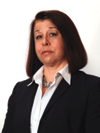Catching Up With Filiz Yavuz, Perry Ellis International
 CGT Executive Editor Kara Romanow catches up with Filiz Yavuz, vice president of business process engineering for Perry Ellis International, and uncovers tips on how to combine great products with the great analytical planning processes and technologies to compete effectively in the fast-turning apparel market. Plus, find out how Perry Ellis International is able to keep the acquisition process simple yet effective - Yavuz has seen at least one acquisition a year over the last six years.
CGT Executive Editor Kara Romanow catches up with Filiz Yavuz, vice president of business process engineering for Perry Ellis International, and uncovers tips on how to combine great products with the great analytical planning processes and technologies to compete effectively in the fast-turning apparel market. Plus, find out how Perry Ellis International is able to keep the acquisition process simple yet effective - Yavuz has seen at least one acquisition a year over the last six years. What keeps you up at night?
What keeps you up at night?Yavuz: Many consumer packaged goods companies may not be operating at the speed of the apparel segment or match its SKU intensive requirements. The men's apparel market generally runs on four markets a year and women's apparel lines minimally attend five to six markets per year, requiring new product, new energy and innovation using the best support technology to differentiate them from the competition.
While technology and optimization can drive speed to market and innovation, I perceive the biggest challenge we have is finding more of the right resources with the right analytical skills - sometimes mathematical skills - and the global vision to support the "roller coaster ride" that we have to operate in.
At Perry Ellis, we have put together programs to partner with institutions such as the University of Miami Engineering School and other local institutions in the United States and overseas to build these skill sets and manage talent. New generations coming into our industry in the United States may never have been in a sewing plant or a fabric mill in their lives, and they are challenged with designing new product. Building expertise with global outreach requires taking advantage of the best skills on all regions of the world.
In your opinion, what are some best practices to follow during the merger and acquisition process?
Yavuz: Having gone through at least one acquisition per year in the last six years, the Perry Ellis Executive Management Team leads by being "fiscally responsible" in its strategic evaluation of new companies. That also means keeping things simple once the acquisition is finalized and taking unnecessary complexity out of companies that led to being acquired in the first place. Making the new company or brand part of the existing operational infrastructure without losing a new season of "innovation" and potential sales is the goal. In the process, the teams focus on maintaining the strategic creative value and the vision new brands and product lines bring.
And finally, the operational teams learn from every new merger and acquisition activity and get better every time. In a very recent experience, I was very proud of the PEI MIS team that connected not one but two significant companies to our global network seamlessly within 24 hours of having closed the deal. Granted we have additional work to do merge functional processes - the new companies will at least have the same tools and common metrics to measure their success as we go through the process of rebuilding them. Now, they are busy creating new product where the strategic focus needs to be.
Can you detail both the challenges and advantages that go along with being a global company?
Yavuz: Going back 40 years, Perry Ellis started with a global vision importing apparel from Japan. The year it went public, in 1993, Perry Ellis had more offices overseas than in the United States, providing flexible sourcing alternatives which led to its growth.
The "fashion" network becomes extremely complex when you are managing more than 14 overseas offices, 13 U.S. offices, more than 12 distribution centers, product from approximately 200 active different contract manufacturers from 30 different countries supporting 25 some brands. If you multiply that by the SKU intensive requirements of the apparel industry that has to deliver product to at least 12,000 retail doors around the United States at least four to six times a year, the business model can become quite challenging. A global company has to be able to find its way through this maze and do it efficiently.
Technology is absolutely required to provide visibility and enable faster design, communication and logistics operations in this complex network. While technology provides the foundation, the focus needs to be on simple, practical and nimble processes while not losing sight of customer requirements and market trends.
